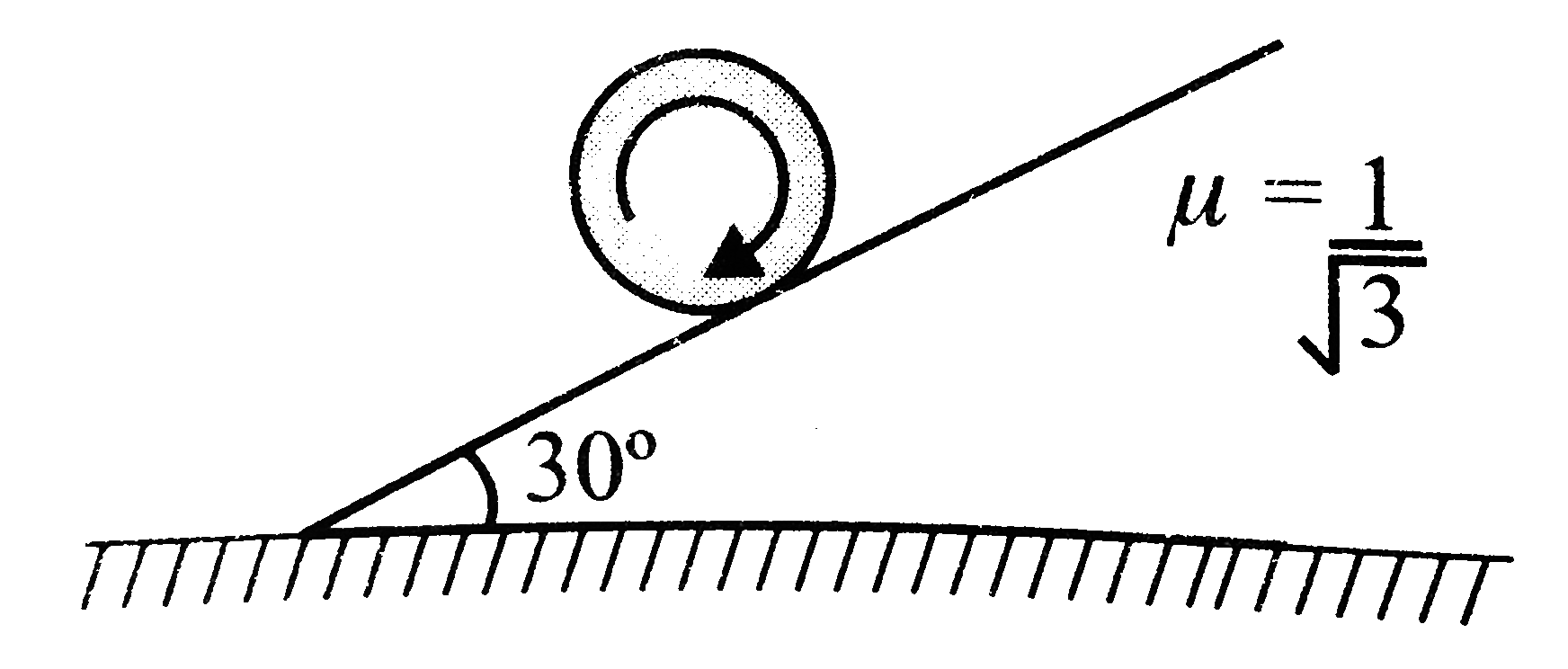A wheel is rotating about its axis at a constant angular velocity. If suddenly an object sticks to it on the rim, then its M.I. will:
increase
decrease
remain unchanged
nothing can be said
The correct Answer is:A
To solve the problem, we need to analyze the situation step by step.
Step 1: Understand the Initial Condition
The wheel is rotating about its axis with a constant angular velocity. This means it has an initial moment of inertia (M.I.) which we will denote as Ii.
Hint: Remember that the moment of inertia depends on the mass distribution relative to the axis of rotation.
Step 2: Define the Moment of Inertia
The moment of inertia for a wheel (considering it as a ring for simplicity) is given by the formula:
Ii=m⋅r2
where m is the mass of the wheel and r is its radius.
Hint: The moment of inertia is a measure of how difficult it is to change the rotational motion of an object.
Step 3: Introduce the Sticking Object
When an object of mass m sticks to the rim of the wheel, we need to calculate the new moment of inertia If.
Hint: When an additional mass is added to a rotating body, it affects the overall moment of inertia.
Step 4: Calculate the Final Moment of Inertia
The new moment of inertia after the mass sticks to the rim can be calculated as:
If=Ii+m⋅r2
Substituting the expression for Ii:
If=(m⋅r2)+(m⋅r2)=2m⋅r2
Hint: The moment of inertia of the added mass is calculated using the same formula, considering its distance from the axis of rotation.
Step 5: Compare Initial and Final Moment of Inertia
From our calculations:
If=2⋅Ii
This shows that the final moment of inertia If is greater than the initial moment of inertia Ii.
Hint: Comparing the initial and final moments of inertia helps us determine how the system's rotational characteristics change.
Conclusion
Since the final moment of inertia is greater than the initial moment of inertia, we conclude that the moment of inertia will increase when the object sticks to the rim of the wheel.
Final Answer: The moment of inertia will increase.
The wheel is rotating about its axis with a constant angular velocity. This means it has an initial moment of inertia (M.I.) which we will denote as Ii.
The moment of inertia for a wheel (considering it as a ring for simplicity) is given by the formula:
Ii=m⋅r2
where m is the mass of the wheel and r is its radius.
When an object of mass m sticks to the rim of the wheel, we need to calculate the new moment of inertia If.
The new moment of inertia after the mass sticks to the rim can be calculated as:
If=Ii+m⋅r2
Substituting the expression for Ii:
If=(m⋅r2)+(m⋅r2)=2m⋅r2
From our calculations:
If=2⋅Ii
This shows that the final moment of inertia If is greater than the initial moment of inertia Ii.
Since the final moment of inertia is greater than the initial moment of inertia, we conclude that the moment of inertia will increase when the object sticks to the rim of the wheel.
Topper's Solved these Questions
- SYSTEM OF PARTICLES AND ROTATIONAL MOTIONBOOK - VMC MODULES ENGLISHCHAPTER - SYSTEM OF PARTICLES AND ROTATIONAL MOTIONEXERCISE - IMPECCABLE
56 Videos
- SYSTEM OF PARTICLES AND ROTATIONAL MOTIONBOOK - VMC MODULES ENGLISHCHAPTER - SYSTEM OF PARTICLES AND ROTATIONAL MOTIONEXERCISE - ENABLE
50 Videos
- SYSTEM OF A PARTICLES & ROTATIONAL MOTIONBOOK - VMC MODULES ENGLISHCHAPTER - SYSTEM OF A PARTICLES & ROTATIONAL MOTIONEXERCISE - IN-CHAPTER EXERCISE F
10 Videos
- UNITS, MEASUREMENTS & ERRORSBOOK - VMC MODULES ENGLISHCHAPTER - UNITS, MEASUREMENTS & ERRORSEXERCISE - IN - CHAPTER EXERCISE - B
10 Videos
Similar Questions
A thin circular ring of mass M and radius R is rotating about its axis with constant angular velocity ω. The objects each of mass m are attached gently to the ring. The wheel now rotates with an angular velocity.
View SolutionA fly wheel is rotating about its own axis at an angular velocity 11rads−1, its angular velocity in revolution per minute is
View Solution
Knowledge Check
A thin circular ring of mass M and radius r is rotating about its axis with a constant angular velocity ω. Two objects each of mass m are attached gently to the opposite ends of a diameter of the ring. The ring will now rotate with an angular velocity of
Aω(M−2m)(M+2m)BωM(M+2m)CωM(M+m)Dω(M+2m)MA thin circular ring of mass M and radius r is rotating about its axis with a constant angular velocity ω, Two objects, each of mass m, are attached gently to the opposite ends of a diameter of the ring. The wheel now rotates with an angular velocity ω=
AωMM+mBω(M−2m)M+2mCωMM+2mDω(M+2m)M
A thin circular ring of mass M and radius R is rotating about its axis with a constant angular velocity omega. Four objects each of mass m, are kept gently to the opposite ends of two perpendicular diameters of the ring. The angular velocity of the ring will be
View SolutionA circular disc is rotating about its own axis at an angular velocity ω. If P is exact midpoint of dise between axis and rim of disc then angular velocity of Pis
View SolutionA stationary wheel starts rotating about its own axis at constant angular acceleration. If the wheel completes 50 rotations in first 2 seconds, then the number of rotations made by itin next two seconds is
View SolutionA disc is rotated about its axis with a certain angular velocity and lowered gently on a rough inclined plane as shown in Fig., then

View SolutionA disc is rotated about its axis with a certain angular velocity and lowered gently on a rough inclined plane as shown in Fig., then

View SolutionA whel of mass 2kg an radius 10 cm is rotating about its axis at an angular velocity of 2πrad/s the force that must be applied tangentially to the wheel to stop it in 5 revolutions is
View Solution
